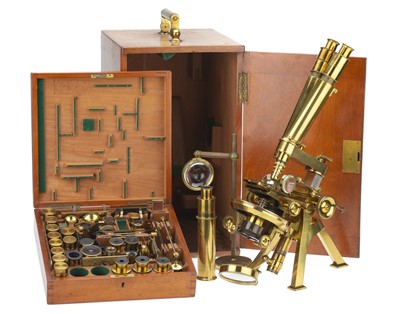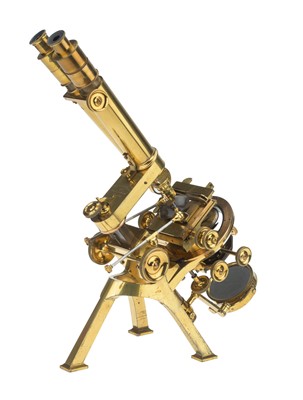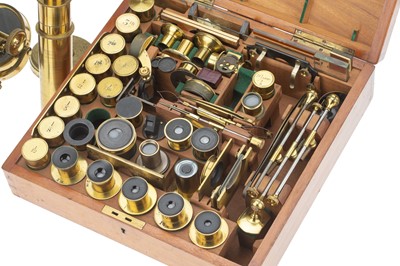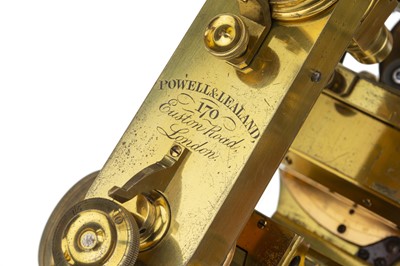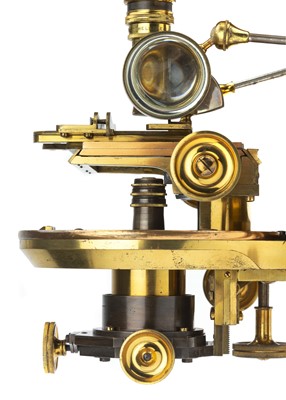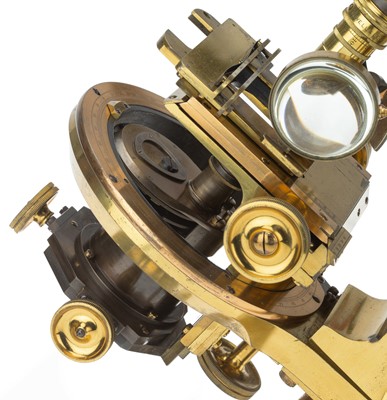12th May, 2022 12:00
Fine Scientific and Medical Instruments
An Exceptional Powell & Lealand No.1 Ring Stage Binocular Microscope Outfit
English, dated 1862, signed in script to the top of the bar-limb ‘POWELL & LEALAND, 170 Euston Road, London’, of standard No.1 construction standing on a massive lacquered tripod base with rectangular feet each with cork pads, trunnions to the top supporting the body, with large plano-concave mirror to the base as typically supported on one side at the end of an articulated arm sliding on a collar, above this is the mechanical sub-stage with screw X-Y control and geared rotation and focusing via rack and pinion, above which is the ring stage with the circle engraved 0-90-0 to each side with a reading point at the front, the whole stage assembly is rotated via a steel pinion at the rear, at the back of the ring is a vertical support to which is fixed the Turrel-type mechanical stage with X-Y control via rack and screw,main course focus to rear of body, bar-limb incorporating fine focus lever mechanism, nose piece with prism blanking plate, limb with threaded boss to accept binocular or monocular tubes,
the microscope comes with the following accessories in a large French polished mahogany case:
A 4in objective & can, objective unsigned.
A 3in objective & can, objective unsigned.
A 2in objective & can, objective unsigned.
A 1in objective & can, objective unsigned.
A 1/2in objective and can engraved ‘Powell & Lealand’.
A 1/5in objective & can, objective unsigned.
A 1/8in objective & can, objective unsigned.
A 1/12in objective and can engraved ‘Powell & Lealand’.
A 1/16in objective and can engraved ‘Powell & Lealand’.
A 1/16in objective and can unsigned missing front element.
3 Leiberkuhn’s.
A vertical illuminator
A pair of low power eyepieces.
A pair of medium power eyepieces.
A high power eyepiece.
A telescopic eyepiece.
An eyepiece micrometer
An eyepiece magnifier.
An eyepiece analyser.
An eyepiece lucida.
A substage achromatic condenser.
A substage spot lens.
A substage polariser.
A substage wheel of stops.
A substage Amici-type prism.
A substage set of dark wells.
A large frog/fish plate.
Various live boxes, compressors, and glass stages.
2 Side reflectors on steel arms.
A condenser on a steel arm.
2 sets of stage forceps.
A Wenham prism in a leather case.
a high power Wenham prism in a brass case.
and other items
Main Cabinet Constructed of French polished mahogany with large brass handle.
Footnote: Powell & Lealand's Model No. 1 was introduced in 1841 and is now considered one of the great masterpieces in the history of microscopy. The No.1 was built by the company for 60 years with little change to the overall design. It has been estimated that the company produced just 10 of these microscopes a year meaning that only around 600 were ever made. The retail price of £200 for the stand alone reflected the extraordinarily high level of attention paid to every detail in both its design and assembly.
Powell and Lealand exhibited their microscopes at the London Great Exhibition in 1862, the year that this particular model was built. The entry from the text of "The International Exhibition of 1862 : the illustrated catalogue of the Industrial Department" reads [ 2946 ] Powell & Lealand, 170 Huston Road. — Microscopes with rotating thin stage; binocular arrangement ; object glasses from 2 in. to 2*3 Hh inclusive.
Sold for £8,500
Result plus buyers premium
English, dated 1862, signed in script to the top of the bar-limb ‘POWELL & LEALAND, 170 Euston Road, London’, of standard No.1 construction standing on a massive lacquered tripod base with rectangular feet each with cork pads, trunnions to the top supporting the body, with large plano-concave mirror to the base as typically supported on one side at the end of an articulated arm sliding on a collar, above this is the mechanical sub-stage with screw X-Y control and geared rotation and focusing via rack and pinion, above which is the ring stage with the circle engraved 0-90-0 to each side with a reading point at the front, the whole stage assembly is rotated via a steel pinion at the rear, at the back of the ring is a vertical support to which is fixed the Turrel-type mechanical stage with X-Y control via rack and screw,main course focus to rear of body, bar-limb incorporating fine focus lever mechanism, nose piece with prism blanking plate, limb with threaded boss to accept binocular or monocular tubes,
the microscope comes with the following accessories in a large French polished mahogany case:
A 4in objective & can, objective unsigned.
A 3in objective & can, objective unsigned.
A 2in objective & can, objective unsigned.
A 1in objective & can, objective unsigned.
A 1/2in objective and can engraved ‘Powell & Lealand’.
A 1/5in objective & can, objective unsigned.
A 1/8in objective & can, objective unsigned.
A 1/12in objective and can engraved ‘Powell & Lealand’.
A 1/16in objective and can engraved ‘Powell & Lealand’.
A 1/16in objective and can unsigned missing front element.
3 Leiberkuhn’s.
A vertical illuminator
A pair of low power eyepieces.
A pair of medium power eyepieces.
A high power eyepiece.
A telescopic eyepiece.
An eyepiece micrometer
An eyepiece magnifier.
An eyepiece analyser.
An eyepiece lucida.
A substage achromatic condenser.
A substage spot lens.
A substage polariser.
A substage wheel of stops.
A substage Amici-type prism.
A substage set of dark wells.
A large frog/fish plate.
Various live boxes, compressors, and glass stages.
2 Side reflectors on steel arms.
A condenser on a steel arm.
2 sets of stage forceps.
A Wenham prism in a leather case.
a high power Wenham prism in a brass case.
and other items
Main Cabinet Constructed of French polished mahogany with large brass handle.
Footnote: Powell & Lealand's Model No. 1 was introduced in 1841 and is now considered one of the great masterpieces in the history of microscopy. The No.1 was built by the company for 60 years with little change to the overall design. It has been estimated that the company produced just 10 of these microscopes a year meaning that only around 600 were ever made. The retail price of £200 for the stand alone reflected the extraordinarily high level of attention paid to every detail in both its design and assembly.
Powell and Lealand exhibited their microscopes at the London Great Exhibition in 1862, the year that this particular model was built. The entry from the text of "The International Exhibition of 1862 : the illustrated catalogue of the Industrial Department" reads [ 2946 ] Powell & Lealand, 170 Huston Road. — Microscopes with rotating thin stage; binocular arrangement ; object glasses from 2 in. to 2*3 Hh inclusive.
Auction: Fine Scientific and Medical Instruments, 12th May, 2022

